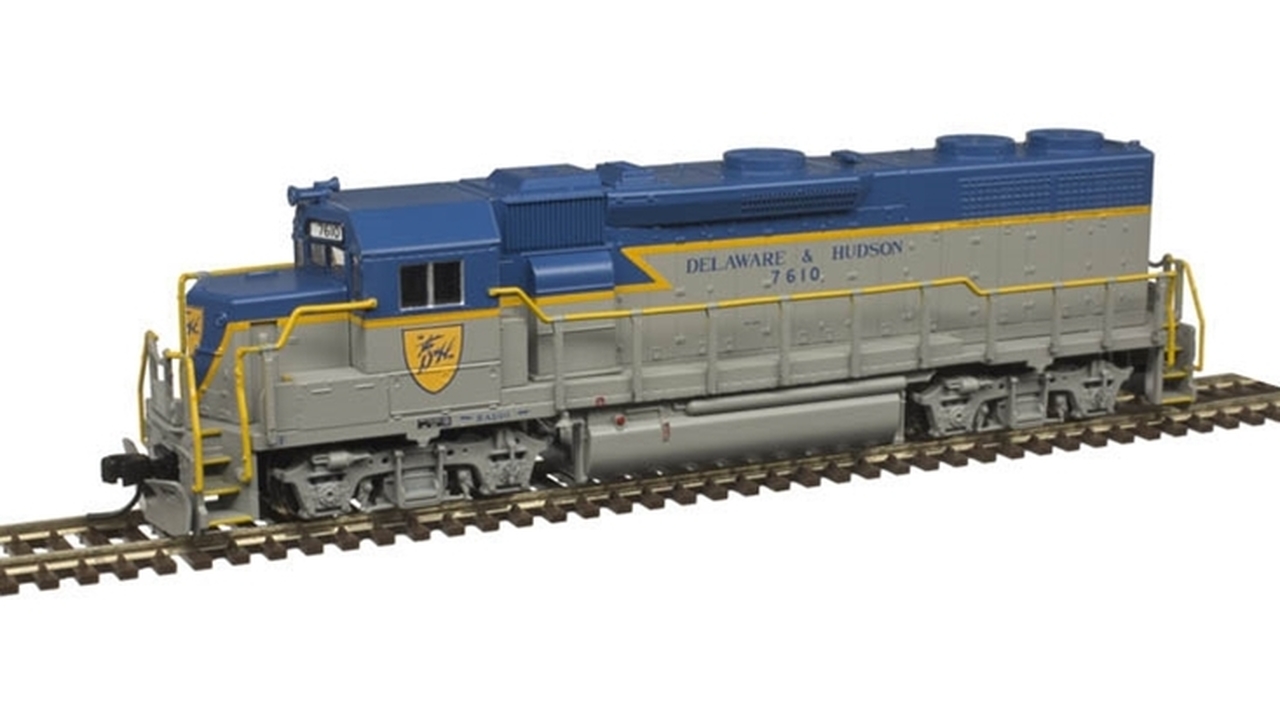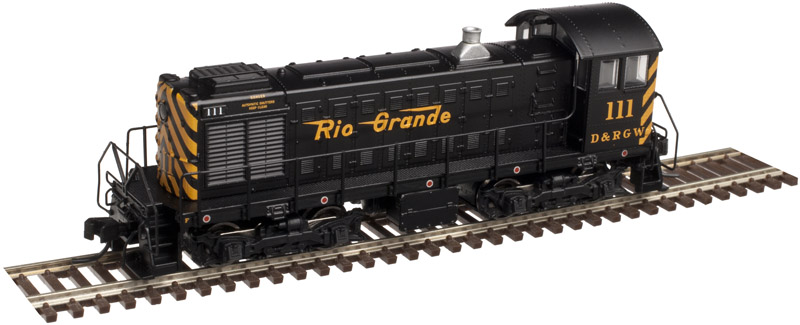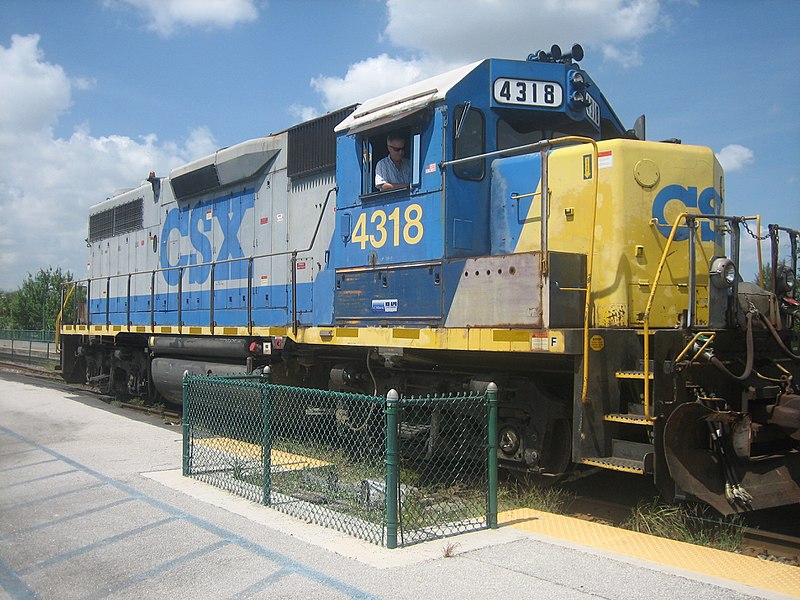Model Information: The Atlas GP39-2 is made in China and has always been made in China. This model was introduced in 2018 and first available through retails in September of that year.
Prototype History: The EMD GP39-2 is a 4-axle diesel locomotive built by General Motors Electro-Motive Division between 1974 and 1984. 239 examples of this locomotive were built for American railroads. Part of the EMD Dash 2 line, the GP39-2 was an upgraded GP39. The power for this locomotive was provided by a turbocharged 12-cylinder EMD 645E3 diesel engine, which could produce 2,300 horsepower (1,720 kW). BNSF 2958 EMD GP39-2,Power sits at Mormon yard on the old Santa Fe at Stockton
Unlike the original GP39, which sold only 23 examples as railroads preferred the reliable un-turbocharged GP38, the GP39-2 was reasonably successful, ascribed to its better fuel economy relative to the GP38-2 which became of more interest in the energy-crisis 1970s, and to its better performance at altitude.
From Wikipedia
From Wikipedia
Road Name History:  The Delaware and Hudson Canal Company would found the Delaware and Hudson Railway to support its mission of getting fuel to the timber denuded cities of the northeast when it was discovered that 'rock coal' or Anthracite could be burned successfully. In time the railway eclipsed the parent company, and America's brief canal age would be ended by the availability of more powerful traction locomotives, so today the canal is little known. Today the Delaware and Hudson Railway (reporting mark DH) is again a subsidiary railroad that operates in the northeastern United States. Since 1991 it was owned and operated by the Canadian Pacific Railway under the rail subsidiary Soo Line Corporation also controls the Soo Line Railroad, Canadian Pacific Railway is owned by Canadian Pacific Railway Limited.
The Delaware and Hudson Canal Company would found the Delaware and Hudson Railway to support its mission of getting fuel to the timber denuded cities of the northeast when it was discovered that 'rock coal' or Anthracite could be burned successfully. In time the railway eclipsed the parent company, and America's brief canal age would be ended by the availability of more powerful traction locomotives, so today the canal is little known. Today the Delaware and Hudson Railway (reporting mark DH) is again a subsidiary railroad that operates in the northeastern United States. Since 1991 it was owned and operated by the Canadian Pacific Railway under the rail subsidiary Soo Line Corporation also controls the Soo Line Railroad, Canadian Pacific Railway is owned by Canadian Pacific Railway Limited.
The name itself originates from the 1823 New York state corporation charter listing the unusual name of "The President, Managers and Company of the Delaware & Hudson Canal Co." authorizing an establishment of "water communication" between the Delaware River and the Hudson River.
Nicknamed "The Bridge Line to New England and Canada," the D&H helped connect New York with Montreal, Quebec and New England. It called itself "North America's oldest continually operated transportation company." Between 1968 & 1984, the D&H was owned by Norfolk & Western. N&W sold it to Guilford Transportation, who cast it into bankruptcy in 1988 and in 1991, the D&H was purchased by Canadian Pacific Railway (CP).
On September 19, 2015, Norfolk Southern Railway assumed control and began operations of their recently acquired Delaware & Hudson "South Line", the 282 miles from Schenectady, New York to Sunbury, Pennsylvania from CP. The Delaware & Hudson "South Line" is a rail route that now consists of three rail lines, the Sunbury Line, the Freight Line, and the Voorhesville Running Track; the Sunbury Line absorbed the original route of the Delaware, Lackawanna and Western Railroad main line which contains the Nicholson Cutoff during that rail line's history.

The name itself originates from the 1823 New York state corporation charter listing the unusual name of "The President, Managers and Company of the Delaware & Hudson Canal Co." authorizing an establishment of "water communication" between the Delaware River and the Hudson River.
Nicknamed "The Bridge Line to New England and Canada," the D&H helped connect New York with Montreal, Quebec and New England. It called itself "North America's oldest continually operated transportation company." Between 1968 & 1984, the D&H was owned by Norfolk & Western. N&W sold it to Guilford Transportation, who cast it into bankruptcy in 1988 and in 1991, the D&H was purchased by Canadian Pacific Railway (CP).
On September 19, 2015, Norfolk Southern Railway assumed control and began operations of their recently acquired Delaware & Hudson "South Line", the 282 miles from Schenectady, New York to Sunbury, Pennsylvania from CP. The Delaware & Hudson "South Line" is a rail route that now consists of three rail lines, the Sunbury Line, the Freight Line, and the Voorhesville Running Track; the Sunbury Line absorbed the original route of the Delaware, Lackawanna and Western Railroad main line which contains the Nicholson Cutoff during that rail line's history.
Brand/Importer Information: In 1924 Stephan Schaffan, Sr. founded the Atlas Tool Company in Newark, New Jersey. In 1933 his son, Stephan Schaffan, Jr., came to work for his father at the age of sixteen. Steve Jr. built model airplanes as a hobby and frequented a local hobby shop. Being an enterprising young man, he would often ask the owner if there was anything he could do to earn some extra spending money. Tired of listening to his requests, the hobby-store owner threw some model railroad track parts his way and said, "Here, see if you can improve on this".
In those days, railroad modelers had to assemble and build everything from scratch. Steve Jr. created a "switch kit" which sold so well, that the entire family worked on them in the basement at night, while doing business as usual in the machine shop during the day.
Subsequently, Steve Jr. engineered the stapling of rail to fiber track, along with inventing the first practical rail joiner and pre-assembled turnouts and flexible track. All of these products, and more, helped to popularize model railroading and assisted in the creation of a mass-market hobby. The budding entrepreneur quickly outgrew the limitations of a basement and small garage operation. Realizing they could actually make a living selling track and related products, Steve and his father had the first factory built in Hillside, New Jersey at 413 Florence Avenue in 1947. On September 30, 1949, the Atlas Tool Company was officially incorporated as a New Jersey company.
In 1985, Steve was honored posthumously for his inventions by the Model Railroad Industry Association and was inducted into the Model Railroad Industry Hall of Fame in Baltimore, Maryland. In addition, Steve was nominated and entered into the National Model Railroad Association Pioneers of Model Railroading in 1995.
In the early 1990s, the Atlas Tool Company changed its name to Atlas Model Railroad Company, Inc.
In those days, railroad modelers had to assemble and build everything from scratch. Steve Jr. created a "switch kit" which sold so well, that the entire family worked on them in the basement at night, while doing business as usual in the machine shop during the day.
Subsequently, Steve Jr. engineered the stapling of rail to fiber track, along with inventing the first practical rail joiner and pre-assembled turnouts and flexible track. All of these products, and more, helped to popularize model railroading and assisted in the creation of a mass-market hobby. The budding entrepreneur quickly outgrew the limitations of a basement and small garage operation. Realizing they could actually make a living selling track and related products, Steve and his father had the first factory built in Hillside, New Jersey at 413 Florence Avenue in 1947. On September 30, 1949, the Atlas Tool Company was officially incorporated as a New Jersey company.
In 1985, Steve was honored posthumously for his inventions by the Model Railroad Industry Association and was inducted into the Model Railroad Industry Hall of Fame in Baltimore, Maryland. In addition, Steve was nominated and entered into the National Model Railroad Association Pioneers of Model Railroading in 1995.
In the early 1990s, the Atlas Tool Company changed its name to Atlas Model Railroad Company, Inc.
Item created by: Jenna on 2018-09-11 16:15:48
If you see errors or missing data in this entry, please feel free to log in and edit it. Anyone with a Gmail account can log in instantly.
If you see errors or missing data in this entry, please feel free to log in and edit it. Anyone with a Gmail account can log in instantly.









